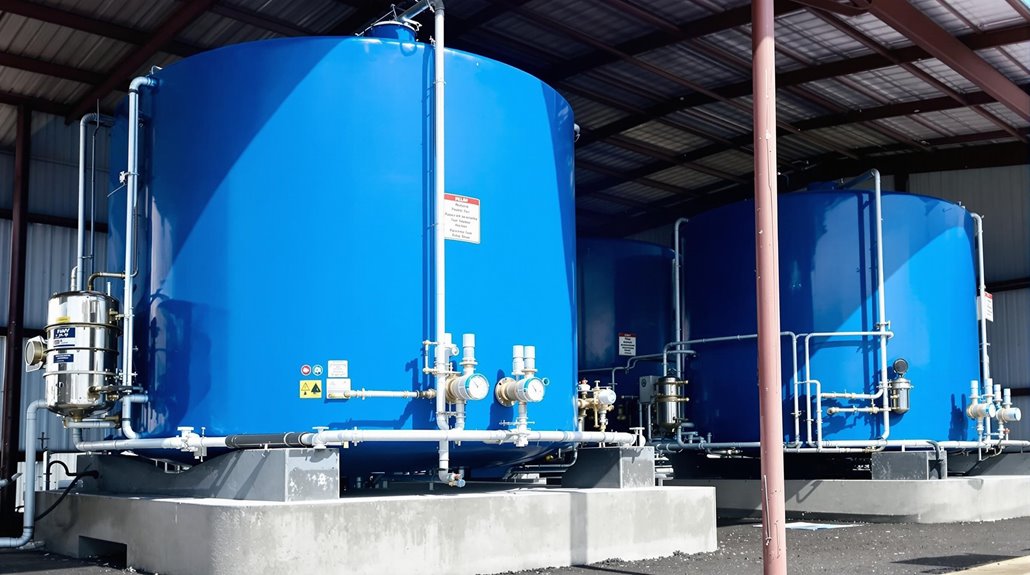To store diesel fuel safely on your farm, you’ll need a properly sized storage tank made of compatible materials like steel or polyethylene, installed on level ground at least 50 feet from buildings. Place the tank on a concrete pad with good drainage and maintain regular inspections for water, rust, or debris. Keep spill kits and fire extinguishers nearby, and follow local regulations for registration and containment. Understanding the complete safety protocols will help protect your farm investment.
Choosing the Right Storage Tank System

When storing diesel fuel for extended periods, selecting the appropriate storage tank system is crucial for both safety and fuel quality.
You’ll need to take into account several key factors, including tank materials and storage capacity, to guarantee you’re making the right choice for your needs.
For tank materials, you can choose between:
- Steel tanks – durable but may rust over time
- Polyethylene tanks – lightweight and corrosion-resistant
- Double-walled tanks – provide extra protection against leaks
Your storage capacity needs will depend on your fuel usage and delivery schedule.
It’s smart to have enough capacity for at least a month’s worth of fuel, plus extra space for expansion and settling.
Remember to factor in local regulations, which often specify minimum distance requirements from buildings and property lines when placing your tank.
Proper Location and Site Preparation
A properly planned storage location for your diesel fuel tank serves as the foundation for a safe and efficient setup. When it comes to site selection, you’ll want to choose level ground at least 50 feet away from buildings and ignition sources.
Consider accessibility for both delivery trucks and your farm equipment while ensuring proper drainage to prevent water accumulation.
Before installation, evaluate the ground stability of your chosen location. You’ll need to prepare a concrete pad or stable gravel foundation that can support the tank’s full weight.
Make sure the area’s free from tree roots, underground utilities, and potential hazards. If you’re planning multiple tanks, space them at least 3 feet apart for easy maintenance access.
Don’t forget to check local regulations, as they might require specific setback distances from property lines and water sources.
Safety Measures and Emergency Protocols
Three essential safety measures form the backbone of proper diesel fuel storage: emergency shutoff systems, spill containment equipment, and firefighting tools. You’ll need to establish clear protocols and maintain proper equipment for effective fire prevention and spill response.
| Safety Item | Required Action |
|---|---|
| Fire Extinguishers | Check monthly, replace annually |
| Spill Kits | Maintain supplies, train staff |
| Emergency Contacts | Post visible numbers, update quarterly |
| Shutoff Valves | Test function every 3 months |
| Safety Signs | Replace when faded, inspect monthly |
Keep your emergency response plan updated and guarantee everyone who handles fuel knows the proper procedures. You should conduct regular safety drills and maintain documentation of all inspections, incidents, and equipment maintenance. Don’t forget to store safety data sheets (SDS) in an easily accessible location.
Maintenance and Quality Control

Regular maintenance checks and quality control testing form the essential foundation for keeping your diesel fuel in ideal condition.
By conducting routine fuel testing and tank inspections, you’ll guarantee your stored diesel remains usable and free from contamination. You’ll want to establish a consistent maintenance schedule that includes both visual checks and professional analysis of your fuel quality.
- Schedule monthly tank inspections to check for water accumulation, rust, or debris that could compromise fuel quality
- Perform quarterly fuel testing to measure particulate levels, microbial growth, and overall fuel stability
- Document all maintenance activities, including dates of inspections, test results, and any corrective actions taken
Remember to adjust your maintenance frequency based on storage conditions, climate, and how quickly you use your fuel supply.
Legal Requirements and Environmental Compliance
When storing diesel fuel on your property, you’ll need to comply with both federal and state regulations designed to protect the environment and guarantee public safety.
To meet regulatory standards, you must register your storage tanks with local authorities and maintain detailed records of fuel purchases, usage, and spill prevention measures.
Install proper containment systems to minimize environmental impact, including spill barriers and leak detection equipment.
You’ll also need to:
- Post clear warning signs and emergency contact information
- Maintain up-to-date safety data sheets
- Schedule regular inspections by certified professionals
- Keep spill response kits readily available
- Document all maintenance and testing procedures
Remember to check with your local fire marshal and environmental protection agency, as requirements can vary by location and tank size.
Don’t forget to renew permits and certifications before they expire.
Conclusion
By implementing these best practices for diesel storage on your farm, you’ll create a safer environment for your family and workers while protecting your valuable fuel investment. Remember, proper storage isn’t just about following regulations – it’s about preserving your farm’s legacy for generations to come. With regular maintenance and attention to safety protocols, you’ll have peace of mind knowing you’re handling your fuel resources responsibly.

